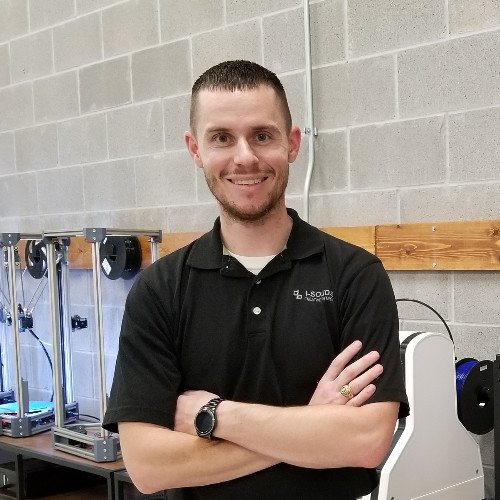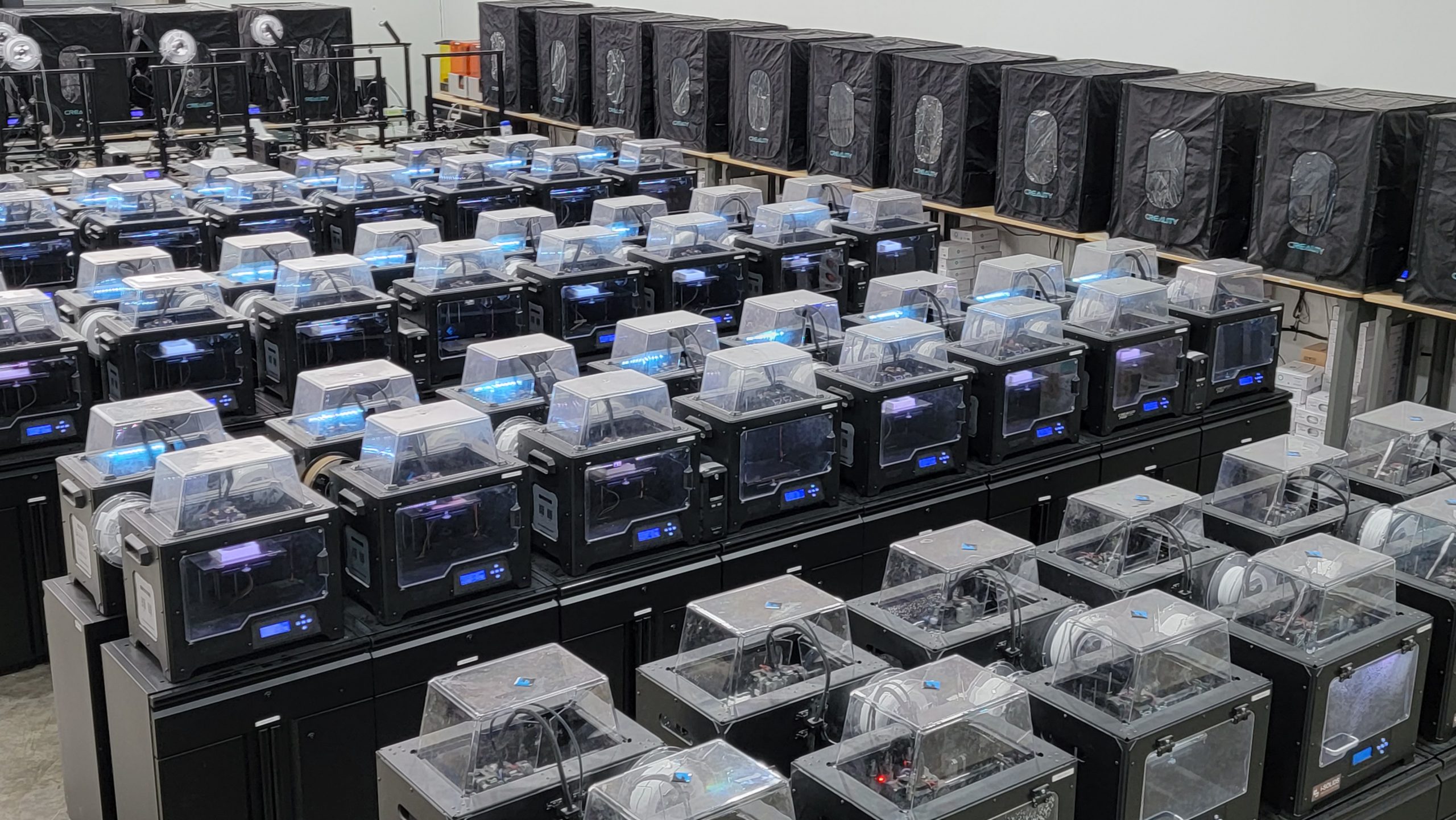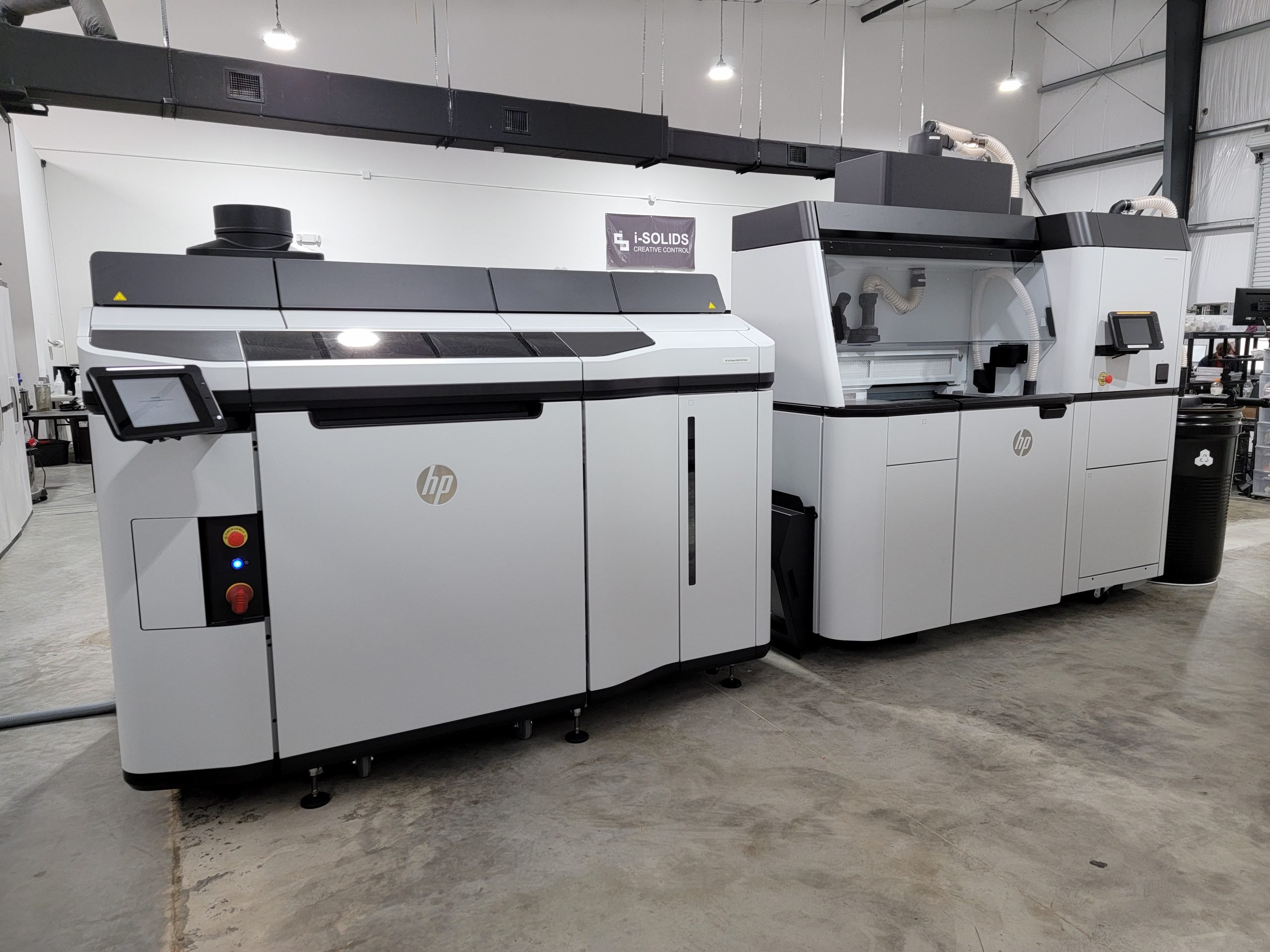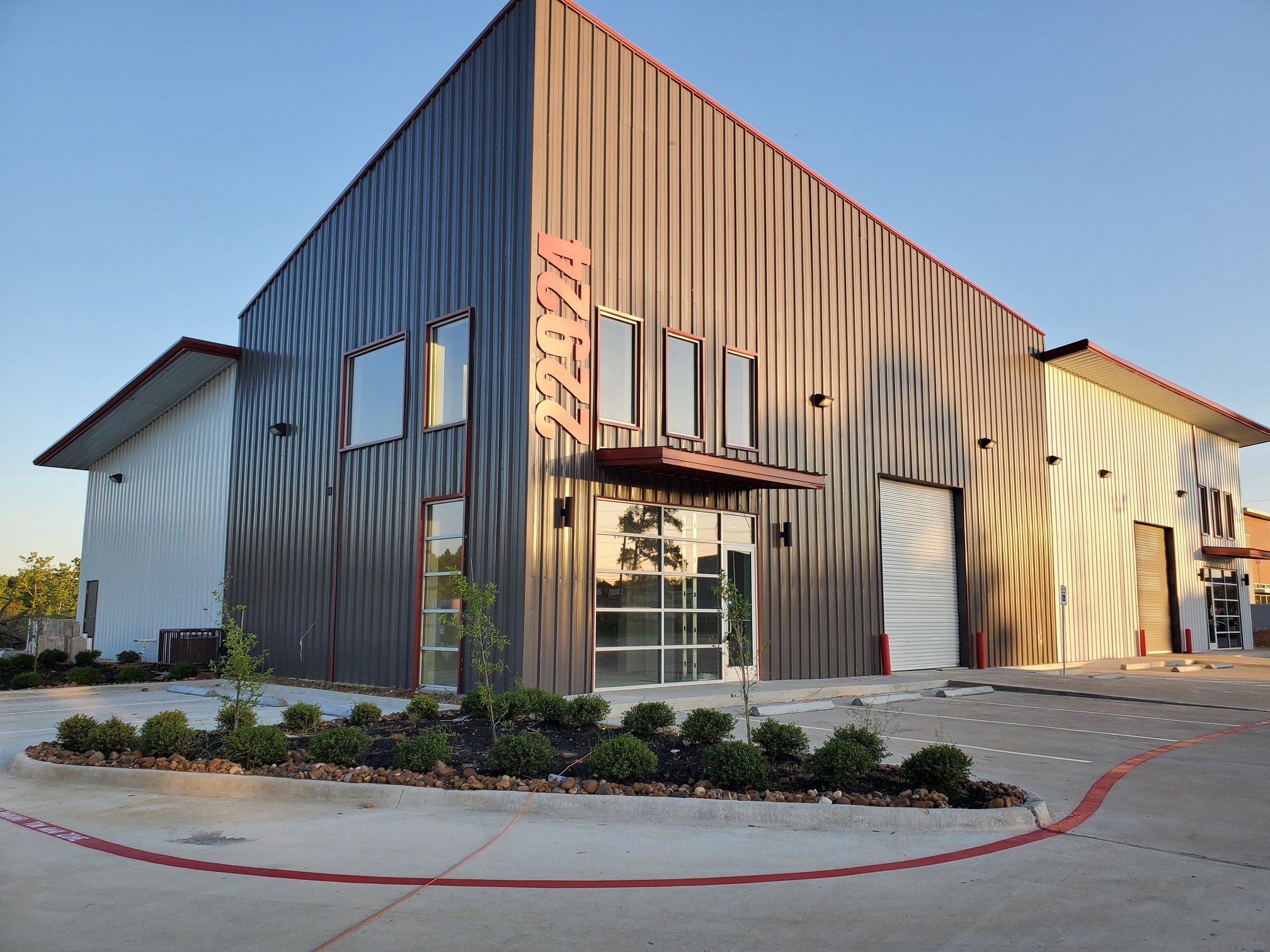Interview with Kason Knight, Owner of i-Solids
27
September, 2021

Recently, I had the privilege to sit down and talk with Kason Knight, the owner of I-Solids about his 3D Printing/Additive Manufacturing Bureau. I have known Kason for a little over 2 years and have watched him grow from a small one-man shop to a facility with 10+ employees. And now, he is about to expand again.

Paul Cesak
Hi Kason. I’m glad we could get together to talk shop. Please tell me about your educational background and how that lead you to 3D printing.
Kason Knight
I’ve been very much into computers dating back to high school and early Java programming. I was intrigued with computers but I found early on that people would constantly ask me for computer advice and so I thought…I’m going to do something a little broader for college and ended up going the mechanical engineering route. But I had a draw towards the computer side of things as well. Programming and data analytics and things like that. So, I ended up going into mechanical engineering at Texas A&M and got my undergraduate there. When I came out, I started working in the oil and gas industry and simultaneously got a master’s degree from Georgia Tech in mechanical engineering as well. I think the combination in both the computer programming hobby as well as the mechanical engineering, technology, education, and experience all helped to shape my path. The fact that 3D printing combines a lot of those two components both in the programming side of the machines, the G code component, and of course all the mechanical designs of the machines themselves. So that’s what drew me to it. It really took my two main passions and combined them together. And along with some CAD designs, are some artistic components that are kind of built-in as well. It’s just one of those things…that all the tiny little things that I enjoyed doing were included in 3D Printing.…and that’s what’s really intriguing for me.

Paul
What was your first machine?
Kason
We bought a MakerBot Replicator clone, one of the knockoffs after the MakerBot era started to spread out a bit.
Paul
Were you doing that for yourself or were you in business when you bought that machine?
Kason,
I was planning to do engineering consulting at the time the oil and gas industry was quickly evolving in an unfortunate downward trend. I was doing some engineering consulting design work on the side, and I thought… hey, I’m going to buy this 3D printer because my previous experience with 3D printing was during my undergrad at A & M. There is a very expensive $100,000 + Stratasys machine and now I’m seeing a $2000 machine that could produce somewhat similar results. So, I was intrigued by that, and I was seeing that maybe I could use that to supplement the engineering CAD work. But I quickly saw that the way the technology was evolving, we could basically scale that upwards. And it would be more than just prototyping but rather… full scale manufacturing at that point.
Paul
And there became I-Solids.
Kason.
And there became I-Solids. Ironically, our business started off as engineering and with 3D printing as a supplement, and now we’re primarily 3D printing as a core business with engineering to supplement that.
Paul
What do you feel has been the biggest change in the 3D printing/additive industry?
Kason
I would say in the last two to five years, the biggest change that I’ve seen is the material science; and the material depth of what is available out there. Early on, especially on what I would call consumer-grade machines, there’s a focus on ABS and then after that…quickly came PLA. And that changed the ability for a lot of people to pick up and generate quality prints at a much lower learning curve or a shallower learning curve. Since then, we’ve seen PETG, ASA, Carbon Fiber Nylons…and all these that I would call engineering-grade polymers in the FDM space. That really changed the attitude that these prints were only of high enough strength and quality for prototyping. And now there are materials that are suitable for end-use applications and not only just mechanical applications. Food safe applications, biomedical applications, and the list goes on and on whether it be jewelry and or castables. For example, on the resin base, that’s where there’s a huge library of materials that are flexible, elastic, castable; anything…and everywhere in between. I think that is what has really driven a lot of new applications to look at additive manufacturing as a suitable alternative to their existing methods of manufacturing.

Paul
What is your favorite 3D printing technology?
Kason
I am very biased, but I believe that MultiJet Fusion produced by HP is a prime example of how additive manufacturing can be used for high volume, end use, functional parts. And it really has changed the mindset that 3D printing is only suitable for prototyping. I think the main driver is the cost, the speed, and the quality. And all three of those are substantially improved. We also run a print farm on FDM. There’s pros and cons to both those different technologies and we have what we call nozzle power on the FDM side; the more machines that we have, the more throughput we can produce. On MultiJet Fusion, FDM cannot compete with the number of parts that can be produced in a certain amount of time…just because of the way that the technology is based. And that allows us to not only think about hundreds of parts but 10s of thousands of parts that can be produced. And the best part about it is…with certain postprocessing techniques, most people won’t even know that it’s 3D printed part.
Paul
What has been your favorite project so far?
Kason
That’s a tough question. There’s a lot of cool projects but I’m sitting here a little tongue-tied because most of what we do is with small business, you know, developing engineering companies, that have new products. And so, some of our favorite ones…unfortunately, we can’t talk about. But I can talk in “vague” and there is one project, about a year ago, during the peak of the COVID lockdowns. There was also a lot of emphasis on supply chain disruptions as well as getting medical supplies into critical areas. We started working with a local company that was developing a virus-killing ultraviolet light application. And they had a very strong customer demand in a very short time frame. They also did not have their supply chains readily available that you would expect in a new application. So, for that reason, we were able to shift and use 3D printing in a way that I had personally never seen scale up so quickly to such high demand. Not only was the project itself something that was very rewarding regarding how it’s being used…but the technology behind it was also very intriguing. It was the application and the insight into what we had been really talking about…how additive manufacturing could in fact fill these supply chain gaps. It was a perfect and prime example for it. So, it’s somewhat rewarding from that standpoint being able to say yes, this is exactly what we’ve been saying this can do for you.

Paul
What do you think are the remaining challenges leading to the global adoption of 3D printing?
Kason,
From my standpoint, the biggest challenge is changing traditional design habits. The reason I say that is because most people will come to 3D printing as a possible alternative to a part that has already been designed with other traditional manufacturing methods in mind. And that doesn’t fully utilize what is capable with additive manufacturing. Such as new cost, weight reduction and the fact that you can do faster production speeds. When you look at some of those limitations, that are traditionally inherent to whether it be injection molding or CNC machining, those are no longer obstacles with many added manufacturing technologies. If you remove those obstacles from the design standpoint, then it opens up more opportunities for more adoption across the stream as well as making it more cost-effective across the board. So, I would say just getting rid of those traditional design mentalities.

Paul
With the current climate in reduced capital spending and new tax implications for large corporations, how will this affect folks getting into 3D printing…or do you think they will just continue to buy parts from folks like you?
Kason
Well of course I’m biased. Right away, I think our business is based around helping solve that problem. I look at it from the computing perspective. Twenty years ago, people were buying servers and installing them in their office buildings, and they were these big expensive hardware investments that have a very definitive end of life, not only from a technological standpoint, but also the support standpoint. That hardware will eventually be obsolete. Look at what Amazon did. Basically, in the background, Amazon is making money selling consumer products, but their growth has been in Amazon Web Services. They took a solution to a hardware problem, and they implemented a virtual digital substitute for that. And in many ways, that’s what we offer as a service; where somebody has a hard time putting a substantial outlay of money into a possible short-term solution that does not have a very definitive ROI. So, there’s a risk. And that risk could very well pay off or it could go the opposite way; and many times, there’s no way to know one way or the other. But what we offer is a service to basically scale up…so you don’t have to buy this big industrial server that might be outgrown; or it might not be big enough…or anywhere in that spectrum. So, we could scale up, we can scale down, you can come and go as you need; you can basically pay for what you want and that’s what Amazon did. They created this ability to turn on a server in the flip of a switch and that’s what we basically offer. And I think Service Bureaus like us, will continue to grow because of that. And I think society is also drawn to this instant gratification. From the customer standpoint, if I look at buying a machine, I must have the volume to support the machine and I must wait for machine to be delivered and installed. And there’s a big investment. Or I can click a button over here and my parts arrive in two days. So, from that standpoint, it’s a lot easier to make those smaller investments overtime with better risk analysis.
You see this implemented everywhere; there’s what I call microservices. They’re all over the place. You can log in and you can download an app to have a handyman come over and do pretty much anything you want. You can log in to have a driver, drive your lunch from a restaurant to your building. So, these microservices might not seem like they have a valuable appeal because of the expense, but everybody’s time is worth something and everybody’s time may be more valuably spent somewhere else. I look at it from the standpoint of mowing my grass. I enjoy it and I have no problem with the work and the time that it takes. But the reality is it might take me 4 hours to do something that somebody else can do in 30 minutes and if I calculate what the time spent on the weekend…my time is more valuable being spent with my family during that time. And so it’s not the work that scares me away from mowing my grass, it is the fact that my time is more valuable being somewhere else and I think that’s the same thing I think people are just naturally gravitated towards. Doing the things that they’re best at. Same with us; there are certain products or certain technologies or certain things that are not our core business. But there are certain things that we are very good at and so we’re going to focus on those. We’re going to do them very well and that’s the offering that we can provide our clients as well.


























0 Comments